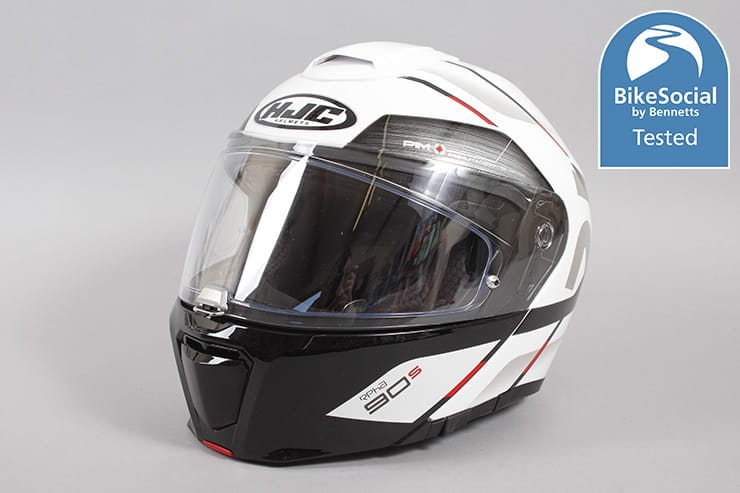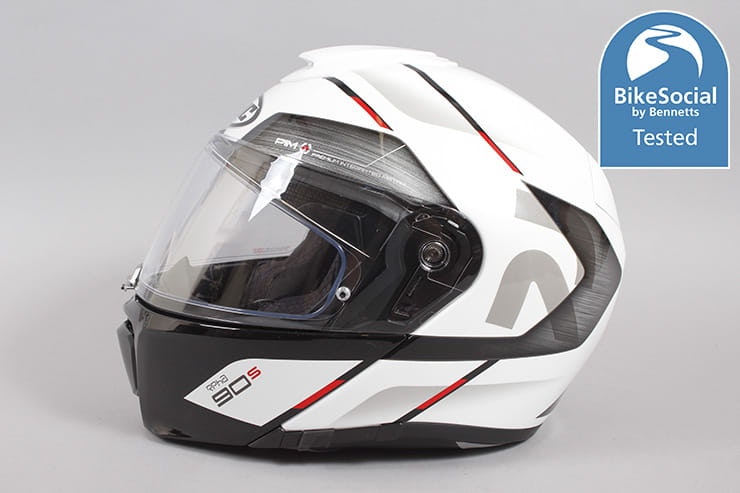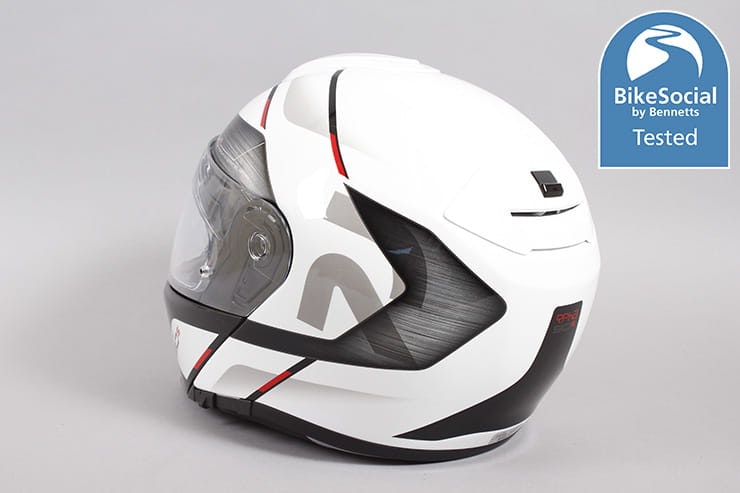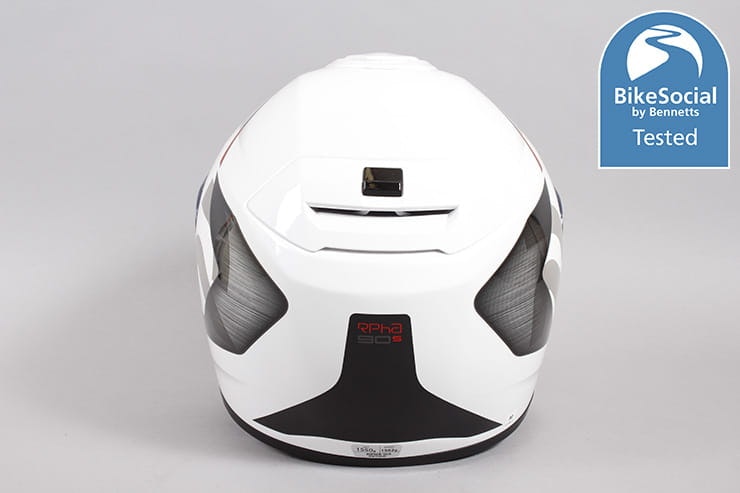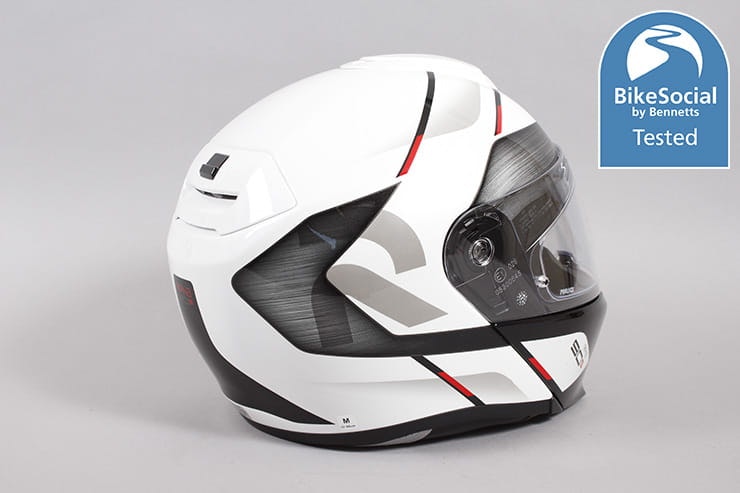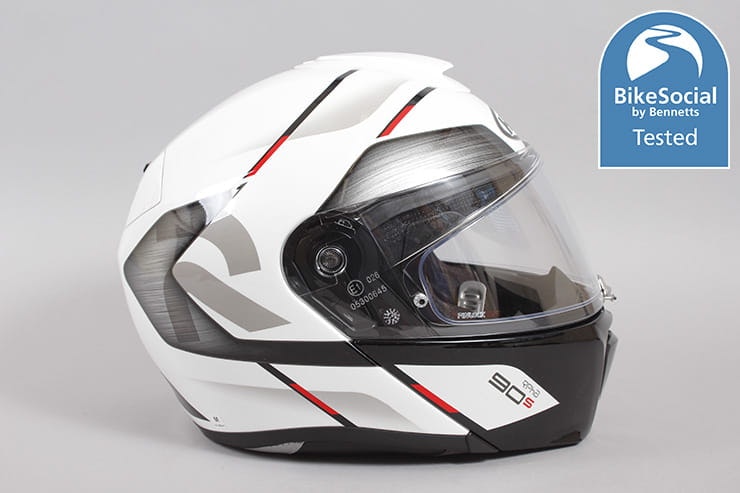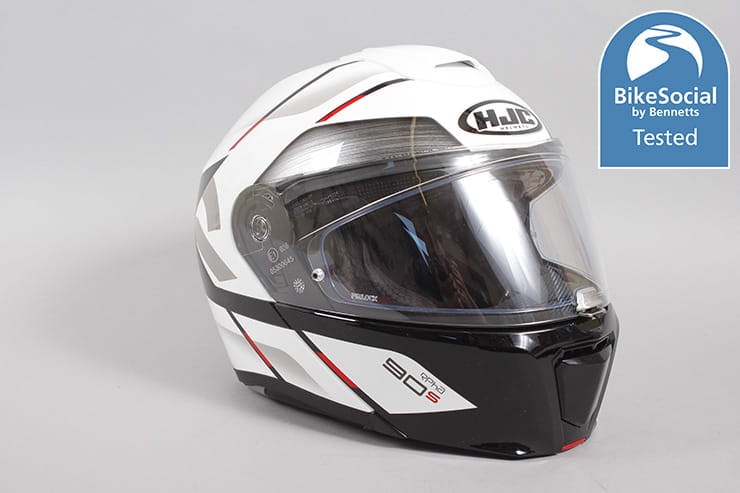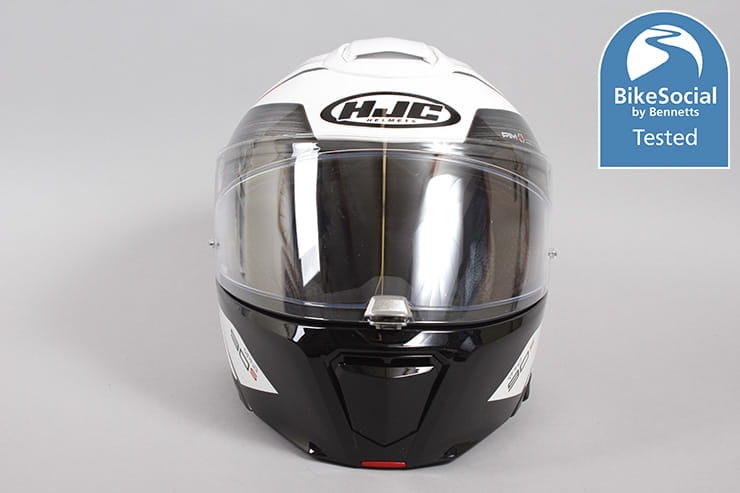HJC RPHA 90S review | Flip-front motorcycle helmet
By John Milbank
Consumer Editor of Bennetts BikeSocial
08.06.2021
Date reviewed: June 2021 | Tested by: John Milbank | RRP: From £419.99 | www.oxfordproducts.com
The HJC RPHA 90S on review here is the company’s top-of-the-range flip-front.
If you’ve never tried a modular helmet before, don’t be too quick to dismiss them as they can be great when touring in the heat and you want to flip it open, not to mention of course the fact that, when everything’s back to normal, you still won’t have to take your lid off to fill up with fuel. And when chatting to other people, you can leave it on.
I’ve been using the 90S on a BMW S1000XR and Yamaha Tracer 9 GT to find out if this is a serious competitor to the benchmark Shoei Neotec II…
Outstanding visor mechanism
Doesn’t force you to use HJC’s intercom
Great build quality
I find it very tight on the cheeks
Vents are just okay (though visor helps make up for this)
A bit too easy to catch the chin-bar button
Outer shell
This is the Bekavo MC1 Red colour scheme of the HJC RPHA 90S, which with a multi-fibre and resin shell sits in the middle of the range at £469.99. You can get it in plain black, white or fluorescent yellow for £419.99, or with a carbon-fibre outer shell for £499.99 (£519.99 with graphics on the carbon). Like most flip-fronts, the chin section is plastic.
The RPHA 90S is dual-homologated to ECE22.05 as P or J, meaning it can legally be used open or closed while riding.
Overall the feel is very much of a high-quality helmet, with excellent trim and nice detailing to the graphics, including a brushed-metal look and a subtle metallic flake to the base-white and the black sections, plus reflective panels on the front above the visor aperture, and on the bottom of the neck skirt at the rear.
The chin bar is opened and closed via an easy-to-find red button; while you do grow accustomed to it, I find it’s a bit too easy to pop it open when feeling around for the chin vent or faffing with a neck-tube.
The HJC closes securely, but I need to give it quite a press as the cheek pads are very tight on me, which pushes the sides of the helmet out, requiring more force to lock it down.
Weight
The RPHA 90S is claimed to weigh 1,562g though there’s always about 50g leeway in that; this medium tipped my scales at 1,608g, which compares well with the 1,793g of the Shoei Neotec II (though that’s with the intercom fitted), but it’s more than the 1,488 of the carbon-fibre Schuberth C4 Pro. The standard C4 pro weighs 1,695g with the company’s own Sena-made intercom fitted. The lightest flip-front lid I’ve tested is the AGV Sport Modular at 1,435g.
Ultimately, while people often get hung up on weight, I’ve yet to find a lid that’s truly heavy on the neck – any issues tend to be caused by wind drag, and I noticed no issues with the HJC at all.
Ventilation
The chin, top and exhaust vent can all be opened or closed and provide a reasonable, if not outstanding, level of ventilation (the Arai Quantic full-face is currently my new benchmark).
Ventilation performance will always be influenced by how much wind reaches your head thanks to your fairing, but the chin vent does seem to feed up to the brow, and while there’s not a noticeable difference when closing the exhaust on the rear, air does move through quite well, and it all seals up for winter use to good effect.
What does help is that it’s very easy to crack the visor just open for more air – either just off closed or open by a couple of centimetres. Also, needless to say if you really want the wind in your face, just flip the chin bar fully open.
Finally, the chin skirt can be removed to allow more air to be drawn up into the front of the closed lid.
Visor
I’m very impressed with HJC’s visor mechanism. For a start, you can easily just crack it open off locked, then the next step of the six-stage smooth ratchet is a useful two-centimetre gap.
It’s also ridiculously easy to remove and refit the visor – overall, the 90S visor is outstanding.
It is worth noting that the visors aren’t the same across the HJC range; I have an RPHA 11 that’s just as good in use, but the two visor’s aren’t compatible, so if you have a spare or dark visor for one, it won’t necessarily fit the other, depending what models they are.
The release catch is in the middle, which makes it much easier to open with your right hand when you’re stopped at a junction with the clutch held in, though there is a weird – and what seems completely pointless – tiny sliding lock built into this catch.
A top-of-the-range Pinlock Maxvision 120 anti-fog insert is supplied, though while the field of view is good, the RPHA 90S has a slightly shallower opening at the sides compared to the likes of the Neotec II.
The drop-down sunshield is operated by a slider on the left of the helmet, and it comes down to sit just above my nose, leaving a minimal line of bright light between the bottom edge and the visor aperture, something that can be a problem for me with some lids.
The seal along the top of the visor is excellent, preventing any water from running down the inside during the rain.
Note that while in the past there have been isolated reports of cracks forming around the screws on some HJC visor locks, in my testing – and confirmed by independent labs – this is down to the use of inappropriate chemicals on the shield. Polycarbonate is prone to micro-fractures, and these are exacerbated by ‘stress risers’ like the screw points. It’s not that the screws have caused the cracks; they’ve just highlighted that the visor has been exposed to harsh chemicals. Petrol is an obvious one, but few people would clean their visor with that. However, some products used in bike and car cleaning will very quickly cause cracks in polycarbonate. For more details, see our cleaners test.
Lining
As you’d expect of a premium lid, the RPHA 90S has a plush, comfortable liner that’s fully removable for washing.
There are no quick-release emergency cheek pads to aid removal of the lid in an accident, though of course these are unnecessary on a flip-up lid.
There a recesses for intercom speakers (plugged with inserts to keep noise down if you’re not using one), and a slot in the rear for HJC’s own unit, but it’s great that you’re not forced to use this by mouldings on the sides, as in the Shoei Neotec II; if you want to use your own brand of intercom, there’s plenty of space on the 90S.
Fastening
The fastener is a high-quality micrometric metal ratchet that gives a very secure fit but that can operated even with winter gloves on; without doubt, I believe this is the best option for a touring-focussed helmet .
Fit
Fit is very subjective, and while the head-shape of the HJC is great for me, the cheeks are very tight. I typically get on well with Arai and Shoei, find Schuberth a bit awkward, and around half of the Shark range suit me.
I mentioned that the sides of the lid are pushed out when it’s open, making closing the chin section a bit harder and requiring more force, but after a two-hour ride I ended up having to run with the front up as my jaw was aching so much.
It’s very important to try any helmet on properly before buying it as something that feels a minor irritation in the store can be a real problem after an hour or so in the saddle.
I certainly don’t have an action hero’s jawline, but this fit issue does appear to be something I find with all HJCs to some extent (like the RPHA 11, tested here). However, it’s only in this 90S that it’s proved to get so uncomfortable for me.
As a spectacle wearer, this helmet is no problem at all, my glasses sitting properly on my nose, with no undue pressure at the sides of my head or behind the ears.
Noise
Flip-up (or ‘system’) helmets always tend to be noisier than a well-designed full-face thanks to the gaps in the sides, but I wouldn’t say the RPHA 90S is any worse than others I’ve tried and it certainly didn’t cause me any irritation.
Ear-plugs are needed for any helmet, and this one’s no different, but the biggest influence on any noise tends to be the design of your bike’s fairing and screen. Many helmets are designed in a wind-tunnel, but only ever with a naked bike, so always be wary of claims that a lid is exceptionally quiet – your experience could be very different due to the tiny variations in turbulence caused by all the parts of your bike, your height, how you sit and finally, the design of the helmet.
For more information on why earplugs are vital with any helmet, and advice on which are the best, click here.
Shot with direct flash, the reflective areas really light up
Three alternatives to the HJC RPHA 90S
This is at the upper end of the market, so you’ll be looking at some of the other top-line products at this price, though the HJC does still offer relatively good value…
The Shoei Neotec II is the obvious comparison, being a hugely popular helmet. Personally, I find it a better fit for my head than the HJC, though I did notice that rain can get into the top vent in severe storms. Starting at £519.99, it’s a £100 premium over the RPHA 90S.
Schuberth’s C4 Pro starts at £499.99, but I had issues with the neck skirt when I tested one. That’s a personal fit thing, but there the C3 Pro is still available at around £360, which I preferred when I used one back in 2015 and is fairly quiet for a flip.
If you want the convenience of a flip-front, but a chin bar that doesn’t sit on top of your head, consider the LS2 Valiant II, reviewed here. From £249.99 it’s well worth a look.
These are just three of many alternatives – you can find all the helmets we’ve tested here.
HJC RPHA 90S review: Verdict
Placed against the offerings from the likes of Shoei and Schuberth, the HJC RPHA 90S represents very good value for money.
The visor system really is excellent, and while the venting isn’t the very best, the ability to open the shield just a crack – or of course flip the whole chin bar up – means you shouldn’t ever overheat.
Flip-front lids are excellent for touring, talking to other people, and keeping comfortable – if it weren’t for the personal fit issues, this would be one of my favourite helmets.
